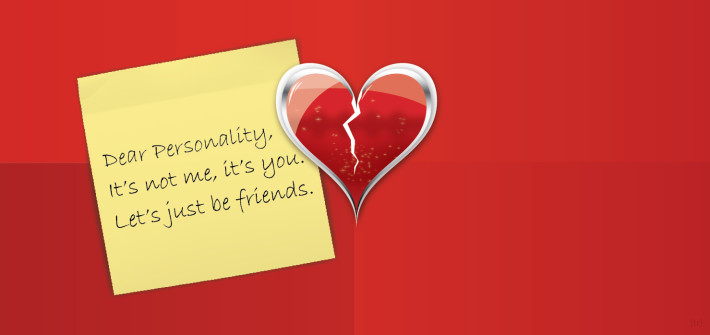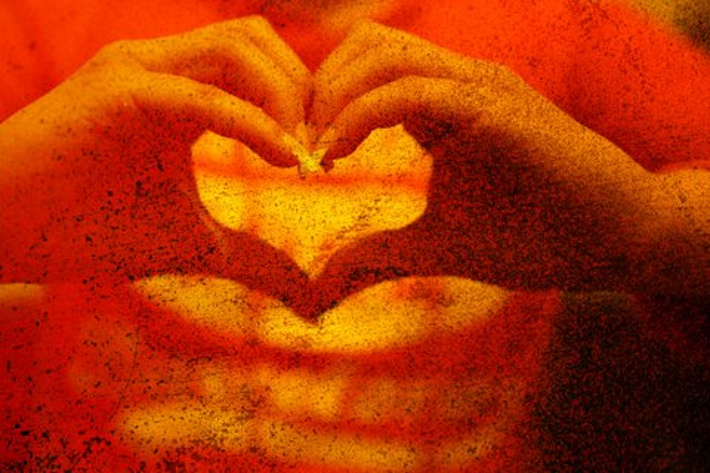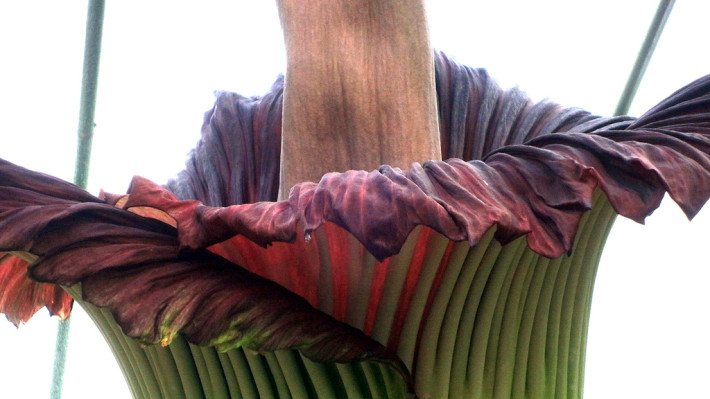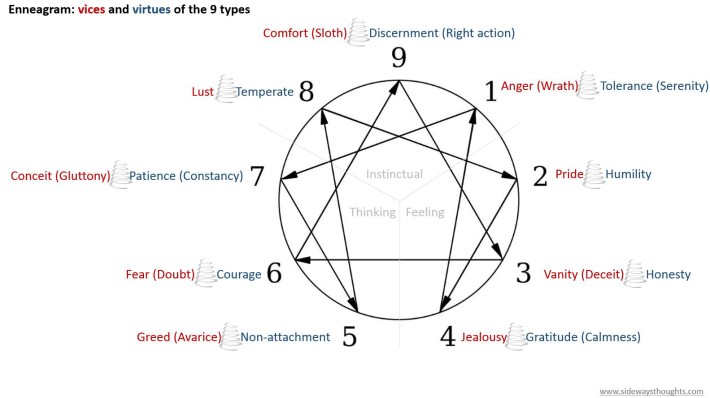Falling out of love with personality through the Enneagram

We love our personality, and so we should. Our personality protects us from real or perceived threats, helps us achieve our ambitions, and generally allows us to survive. Our personality keeps us safe and in turn we feed our personality whatever it wants.
This symbiotic relationship goes largely unnoticed in the recesses of our psyche. We cannot measure our personality directly as you might observe a physical object using a microscope, ruler or scale. We can also find it difficult to describe our personality, relying on metaphors and narrative to say what we are “like”.
So we develop tests to extract our personality from our hidden recesses and display it on screen or paper. We compare ourselves to TV or movie characters, colours, or animals as part of the narrative to tell ourselves and others about who we are. More sophisticated models use terms such as extrovert or introvert, neuroticism or agreeableness, all to help us understand our strengths and weaknesses. Entire industries are created to help us polish our positive attributes and quarantine our weaknesses as we “realise our full potential”.
These approaches promote a sense of celebrating our personality, building our ego as we identify with our type. But what if our personalities were not a means to realise our potential, but were in fact stopping us from that potential? This is a challenging notion when we consider how our personality came to be.
The origins of our love affair

Research into personality has somewhat settled on the awareness that our personalities are both formed by our genetics as well as influenced by our environment, particularly in our formative years. In our early years, we experience a range of real and perceived threats. We navigate these threats by nurturing fight or flight responses, based on innate traits and learned behaviour. The more intense these threats are growing up, such as in situations of neglect or abuse, the stronger our protective responses can be.
These responses develop into predictable habits of beliefs, thoughts, and behaviours. Collectively, these habits create an observable “type” of patterns. These patterns create a self-image that we can love, nurture and protect. We also feel that the self-image in turn nurtures and protects us.
All this to say that we see our personality as working for us. We believe it keeps us safe from pain and suffering and helps us negotiate life. Over the years, these responses become so automatic that they become our personal reality.
Our personality can then shift to protect our reality even when information comes in to tell us that our reality is not accurate. We believe that completing tasks will make us happy as we become increasingly miserable striving for those tasks. We repeatedly obsess over problems despite similar past obsessions not getting us any closer to a solution. We push people away with power or cling to them for approval, neither of which produces satisfying relationships. We increase our control over situations as we receive feedback about being increasingly out of control.
Loving the parasite

Our personality is self-protecting, in that it responds by encouraging us to do more of what seemed to work in the past, only faster and harder with more energy. Unless our habitual responses were challenged when we were younger, our version of reality can be the only reality we see. Our personality becomes adept at shifting and sliding to ensure we are never “threatened” again.
What was previously described as a symbiotic relationship starts to appear more parasitic. The personality lives off its host, directing behaviour to ensure the parasite’s survival even if it means the host will ultimately be hurt or killed. We act out in ways that are seemingly irrational and damaging. We demonstrate anger, fear, or pride that induces stress and anxiety, all under the premise that we are protecting ourselves from harm.
The parasite relies on its ability to remain hidden. We can think that it is “just the way we are”, feeling helpless to change as we are so fully consumed by its influence. It is no surprise then that we attribute such thoughts to the supernatural, giving up control as though “the devil made me do it”.
Exposing the personality

We can, however, get our personality to show itself. One method is putting ourselves in situations of threat or stress. We see it in relationships when an authority figure makes demands of us or a family relation “pushes our buttons”. We can place ourselves in situations where a report is due and we are not prepared, we stand in front of people to make a presentation, we discover we do not have security in our career, or there is unresolved conflict in our team. When situations like these happen and we feel threatened, our personality can bloom like a flower, letting the world see and smell our self-image in all its glory.
Another way to clearly see the personality is to starve it. Our personality consumes the most precious resource we have available: our energy, in the form of thoughts and actions. Our personality constantly seeks out sustenance to satisfy a pallet determined by its type, be it relationship drama, intellectual hubris, or controlling anger.
Meditation is one method of seeing your personality. Letting go and thinking nothing can be one of the hardest journeys we can embark on a society that trades on getting things done, thinking clever thoughts, and controlling situations.
For example, still your thoughts and focus on a single point such as your breath. I suspect after about two minutes, you will begin to see your personality emerge in the form of thoughts, plans, stress and fantasy. As you extend your meditation and continue to come back to the single point of focus, you may see your personality cycle though various approaches to get you to feed its need.
The same principle of fasting your thoughts can be found in fasting for food. This notion of denying your senses to expose the personality was shared by Gandhi when he expressed that “the real seat of taste is not the tongue but the mind”.
The Enneagram as a model for transforming vice to virtue
Saying our personality is a parasite is a metaphor, much like any other model or analogy we create to help us understand our condition. Yet if we do not combine action with our understanding, we are simply feeding our ego, revelling or wallowing in our condition. The primary benefit of exposing our personality is to bring it into consciousness so we can then make a choice about what we feed and where we place our energy.
One model for understanding and taking action about our personality is the Enneagram, a personality framework that can help us both observe our personality as well as make this choice. The Enneagram proposes that we operate from one of nine personality types. Each personality type operates from one of three centres: thinking, feeling and instinct. Each personality type is connected to the other personality types in predictable ways based on the extent of stress a person experiences.
The personality types are characterised by a propensity for a specific vice and potential for a corresponding virtue. This conversion process means the Enneagram model is not two-dimensional, but operates as an upward spiral as a person continues to transform their vice to a virtue through the stages of their life. As they do this, they learn to overcome the vices as well as integrate the virtues of the other personality types.
This transformation process occurs when our life offers opportunities for “rites of passage” from one stage to another. These transitions often involve suffering of some form, be it physical or existential. Typical transitions we see include the development from adolescence, relationship changes, and other experiences involving forms of birth and death. Other transitions can be manually created, such as leaving home, shifts from long-term careers, and pilgrimages or other major physical endeavours.
Our experience with previous transitions can determine our preparedness for future transitions. Challenges we face in leaving home can influence how we approach changing careers or staying in long-term relationships. Failure to progress through past transitions can culminate in a sense of crisis as the person is faced with a potential disparity between their perceived self and the reality of their situation.
If you are interested in your Enneagram type, you can take a test here: http://www.9types.com/rheti/index.php or here: http://integrative.co.za/Enneagram/. You can read more detail about the types here: http://www.enneagram.com.au/The-Nine-Types.html. Be aware that online Enneagram tests can be unreliable for a range of reasons. One reason is that our personality can be invisible to us and we rely on others to see it for us. Another reason is that we often respond based on behaviours, whereas personality incorporates the underlying beliefs and needs that drive those behaviours. This can be more difficult to identify particularly if a person is using the behaviour to hide from those beliefs. There is value however in starting the conversation about your type and the opportunity to convert vice to virtue.
Discover love by falling out of love with personality
While there are many thoughts about why we are here on the earth, a common theme emerges across theology, philosophy and psychology that we are here to learn how to convert our vice to virtue. This is a process outlined by the Enneagram.
It is through this process of converting vice to virtue that we grow and develop. It is only through each individual actively engaging in this process that humanity overall will advance in a meaningful and constructive way. As Martin Luther King states:
“Whatever affects one directly, affects all indirectly. I can never be what I ought to be until you are what you ought to be. This is the interrelated structure of reality.”
This process often begins with an awareness that what we have been doing may not be serving us. As I previously mentioned in my post about self-esteem, this may be when we realise that we are associating our self-worth with our performance or position. We may need to fall out of love with the self-image we have so carefully crafted over the years before we can realise what we are capable of. As confronting as this process can be, it can also be exciting as we realise the opportunity to discover a life outside of our learned threat-based responses.
I invite you to share below if your personality allows you to share on social media and you feel there is value in raising awareness of converting vice to virtue. If you have experience or awareness of converting your vice to virtue, I welcome your comments below so we can all learn and become “all we ought to be.”



3 thoughts on “Falling out of love with personality through the Enneagram”
Comments are closed.